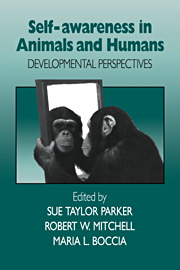Book contents
- Frontmatter
- Contents
- Contributors
- Foreword, by Louis J. Moses
- Acknowledgments
- Note added in proof
- Part I Comparative and Developmental Approaches to Self-awareness
- Part II The Development of Self in Human Infants and Children
- Part III Self-awareness in Great Apes
- 11 Social and cognitive factors in chimpanzee and gorilla mirror behavior and self-recognition
- 12 The comparative and developmental study of self-recognition and imitation: The importance of social factors
- 13 Shadows and mirrors: Alternative avenues to the development of self-recognition in chimpanzees
- 14 Symbolic representation of possession in a chimpanzee
- 15 Self-awareness in bonobos and chimpanzees: A comparative perspective
- 16 me chantek: The development of self-awareness in a signing orangutan
- 17 Self-recognition and self-awareness in lowland gorillas
- 18 How to create self-recognizing gorillas (but don't try it on macaques)
- 19 Incipient mirror self-recognition in zoo gorillas and chimpanzees
- 20 Do gorillas recognize themselves on television?
- Part IV Mirrors and Monkeys, Dolphins, and Pigeons
- Part V Epilogue
- Author index
- Subject index
18 - How to create self-recognizing gorillas (but don't try it on macaques)
Published online by Cambridge University Press: 24 November 2009
- Frontmatter
- Contents
- Contributors
- Foreword, by Louis J. Moses
- Acknowledgments
- Note added in proof
- Part I Comparative and Developmental Approaches to Self-awareness
- Part II The Development of Self in Human Infants and Children
- Part III Self-awareness in Great Apes
- 11 Social and cognitive factors in chimpanzee and gorilla mirror behavior and self-recognition
- 12 The comparative and developmental study of self-recognition and imitation: The importance of social factors
- 13 Shadows and mirrors: Alternative avenues to the development of self-recognition in chimpanzees
- 14 Symbolic representation of possession in a chimpanzee
- 15 Self-awareness in bonobos and chimpanzees: A comparative perspective
- 16 me chantek: The development of self-awareness in a signing orangutan
- 17 Self-recognition and self-awareness in lowland gorillas
- 18 How to create self-recognizing gorillas (but don't try it on macaques)
- 19 Incipient mirror self-recognition in zoo gorillas and chimpanzees
- 20 Do gorillas recognize themselves on television?
- Part IV Mirrors and Monkeys, Dolphins, and Pigeons
- Part V Epilogue
- Author index
- Subject index
Summary
Several years ago, I used the phrase “the anomalous gorillas” while reviewing the nonhuman primate self-recognition literature (Povinelli, 1987, p. 496). At that time, there had been a number of careful, unsuccessful attempts to produce a convincing demonstration of self-recognition in this species (Ledbetter & Basen 1982; Lethmate, cited in Gallup, 1982; Suarez & Gallup, 1981). However, there was one gorilla (Koko) who, based upon uncontrolled (at the time) observations, appeared to show clear signs of self-recognition. The descriptions of Koko's behaviors offered by Patterson (1984) were compelling and comparable to that obtained by Gallup and his colleagues, as well as by other independent researchers working under more controlled conditions with chimpanzees (Calhoun & Thompson, 1988; Gallup, 1970; Gallup, McClure, Hill, & Bundy, 1971; Lethmate & Dücker, 1973; Suarez & Gallup, 1981). Despite this rather remarkable behavior on the part of one member of the species, gorillas as a whole appeared to fall into a different category than chimpanzees, orangutans, and humans with regard to self-recognition. This seemed difficult to reconcile with the evolutionary relatedness of the species within the great ape–human clade; hence my invocation of the phrase “the anomalous gorillas” (Povinelli, 1987).
Several potential explanations for why most gorillas did not appear like chimpanzees on mirror self-recognition tasks suggested themselves, ranging from the hypothesis that they are differentially sensitive to the effects of being reared in captivity, to the possibility that they are simply not motivated to solve the learning problem imposed by the introduction of mirrors (Povinelli, 1987).
- Type
- Chapter
- Information
- Self-Awareness in Animals and HumansDevelopmental Perspectives, pp. 291 - 300Publisher: Cambridge University PressPrint publication year: 1994
- 42
- Cited by

